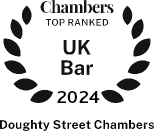Where are all the women?
Have you ever wondered where the names of London’s streets come from? Many of them give recognition to historical figures, but disappointingly few of these are women.
Doughty Street Chambers – and the #DoughtyStWomen - are proud to be based in Bloomsbury, with its rich history of inspirational women leaders from politics, law, journalism, and art.
Within a few hundred metres of our chambers are buildings where the suffragettes built their campaigns, as well as the former home of the first woman barrister in England and Wales. Helena Normanton QC lived and worked a block north, on Mecklenburgh Square.
Yet, the streets we walk every day are named instead for men: many of them wealthy landowners or benefactors whose public contribution stemmed principally from their wealth. Of the women honoured on our street signs now, many are profiled not in their own right but simply as the wives of historically high-profile men.
To celebrate International Women’s Day 2018, and the centenary of women’s suffrage, #DoughtyStWomen are reimagining our streets renamed. For eight days between 1 March and International Women’s Day on 8 March we will focus on one of our local Bloomsbury streets, honouring eight of the leaders of the women’s suffrage movement who had connections in the area and who are too often forgotten.
Follow us on social media and help us honour Bloomsbury’s inspirational feminist history.
#DoughtyStWomen #IWD2018
Day 1: 1 March 2018
Reimagining Doughty Street; discovering Lyons Street.
Doughty Street was built in the 1790s. It is part of the Doughty estate in Bloomsbury, part of extensive lands owned by the Doughty family.[1] The Street was named after Henry Doughty, a member of the family and a landlord of the area in the late eighteenth century.[2]
So, today, welcome to Lyons Street.

We are honouring Jane Lyons, who ran a 'Private Hotel and Boarding House' at 48 and 49 Doughty Street from 1901-1923 (the buildings are now the Charles Dickens Museum).
Born in 1836, Jane Lyons moved in London in the late nineteenth century. Researcher and writer Elizabeth Crawford has described how she had by 1901 become the proprietor of the Boarding House at Doughty Street, and, “on the day of the census, she had 24 boarders – all women – … clerks, teachers and typists (and a stockbroking nephew).” By 1911 her boarders included both men and women.
Miss Lyons gave shelter to many suffragettes at her Boarding House - when they were released from Holloway Prison; when they travelled to London to protest; and to those on the run. It was, for many women, a safe house, providing shelter when they were fighting for their rights.
One such woman was Mary Richardson. In her autobiography, Laugh a Defiance, she describes being given shelter in Miss Lyons’ Boarding House in October 1913, when she was let out of Holloway under the terms of the Prisoners (Temporary Discharge for Ill-Health) Act 1913, commonly known as the ‘Cat and Mouse Act.’ The Act was the Government’s attempt to deal with hunger-striking suffragettes: it allowed for the early release of prisoners who were so weakened by hunger striking that they were at risk of death. They were to be recalled to prison once their health was recovered, where the process would begin again. On 10 March 2014, it was from Miss Lyons’ Boarding House that Mary Richardson set out for the National Gallery when she attacked the Velasquez painting, The Toilet of Venus (known as The Rokeby Venus) with a butcher’s hammer she had bought on the Gray’s Inn Road. Another woman who found shelter at Miss Lyons’ Boarding House was Annie Kenney, a working class suffragette from Manchester who became a leading figure in the Women’s Social and Political Union.
Jane Lyons would have been in her late 70s at this time, when she was providing a roof over the heads of Mary Richardson, Annie Kenney and many others. Her Boarding House was, for many women, a safe house, providing shelter when they were fighting for their rights.
You can read more about Jane Lyons here and here.
[1] Survey of London, vol. 24, 1952, cited by the UCL Bloomsbury Project.
[2] Weinreb, Ben & Hibbert, Christopher (1992). The London Encyclopaedia (reprint ed.). Macmillan. p. 241.







